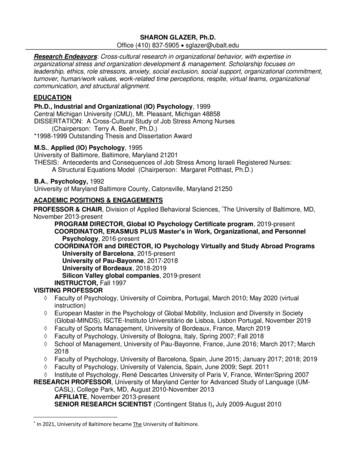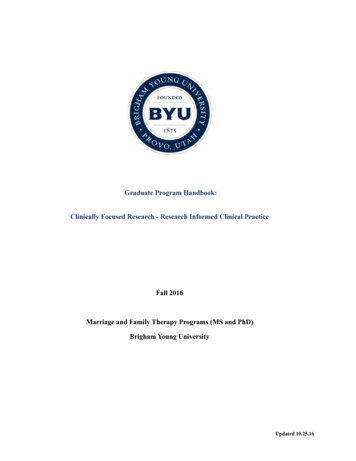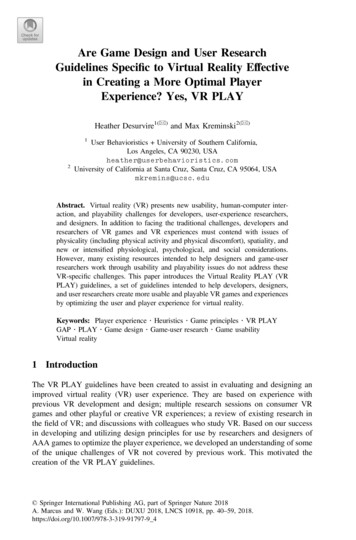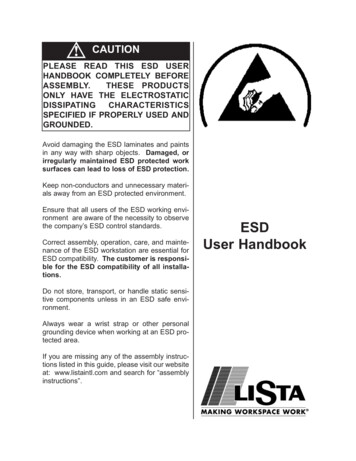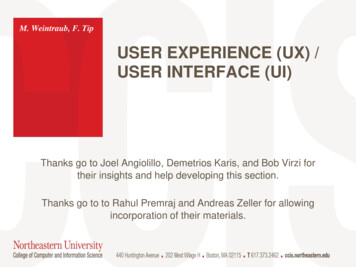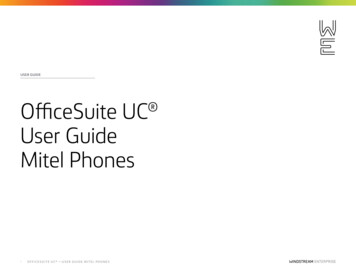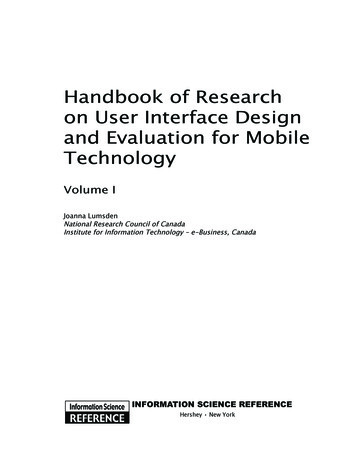
Transcription
Handbook of Researchon User Interface Designand Evaluation for MobileTechnologyVolume IJoanna LumsdenNational Research Council of CanadaInstitute for Information Technology – e-Business, CanadaInformatIon scIence referenceHershey New York
Acquisitions Editor:Development Editor:Senior Managing Editor:Managing Editor:Copy Editor:Typesetter:Cover Design:Printed at:Kristin KlingerKristin RothJennifer NeidigSara ReedJoy Langel, Katie Smalley, and Angela ThorJeff AshLisa TosheffYurchak Printing Inc.Published in the United States of America byInformation Science Reference (an imprint of IGI Global)701 E. Chocolate Avenue, Suite 200Hershey PA 17033Tel: 717-533-8845Fax: 717-533-8661E-mail: cust@igi-global.comWeb site: http://www.igi-global.comand in the United Kingdom byInformation Science Reference (an imprint of IGI Global)3 Henrietta StreetCovent GardenLondon WC2E 8LUTel: 44 20 7240 0856Fax: 44 20 7379 0609Web site: http://www.eurospanonline.comCopyright 2008 by IGI Global. All rights reserved. No part of this publication may be reproduced, stored or distributed in any form or byany means, electronic or mechanical, including photocopying, without written permission from the publisher.Product or company names used in this set are for identification purposes only. Inclusion of the names of the products or companies doesnot indicate a claim of ownership by IGI Global of the trademark or registered trademark.Library of Congress Cataloging-in-Publication DataHandbook of research on user interface design and evaluation for mobile technology / Joanna Lumsden, editor.p. cm.Summary: "This book provides students, researchers, educators, and practitioners with a compendium of research on the key issuessurrounding the design and evaluation of mobile user interfaces, such as the physical environment and social context in which a device isbeing used and the impact of multitasking behavior typically exhibited by mobile-device users"--Provided by publisher.Includes bibliographical references and index.ISBN 978-1-59904-871-0 (hardcover) -- ISBN 978-1-59904-872-7 (ebook)1. Mobile computing--Handbooks, manuals, etc. 2. Human-computer interaction--Handbooks, manuals, etc. 3. User interfaces (Computersystems)--Handbooks, manuals, etc. I. Lumsden, Joanna.QA76.59.H36 2008004.165--dc222007024493British Cataloguing in Publication DataA Cataloguing in Publication record for this book is available from the British Library.All work contributed to this book set is original material. The views expressed in this book are those of the authors, but not necessarily ofthe publisher.If a library purchased a print copy of this publication, please go to cess-agreement.pdf for information on activating the library's complimentary electronic access to this publication.
0Chapter XXITools for Rapidly PrototypingMobile InteractionsYang LiUniversity of Washington, USAScott KlemmerStanford University, USAJames A. LandayUniversity of Washington & Intel Research Seattle, USAabstractWe introduce informal prototyping tools as an important way to speed up the early-stage design of mobileinteractions, by lowering the barrier to entry for designers and by reducing the cost of testing. We usetwo tools, SUEDE and Topiary, as proofs of concept for informal prototyping tools of mobile interactions. These tools address the early stage design of two important forms of mobile interactions: speechbased and location-enhanced interactions. In particular, we highlight storyboarding and Wizard of Oz(WOz) testing, two commonly used techniques, and discuss how they can be applied to address differentdomains. We also illustrate using a case study: the iterative design of a location-enhanced applicationcalled Place Finder using Topiary. In this chapter we hope to give the reader a sense of what should beconsidered as well as possible solutions for informal prototyping tools for mobile interactions.intrOdUctiOnThe iterative process of prototyping and testinghas become an efficient way for successful userinterface design. It is especially crucial to explorea design space in the early design stages beforeimplementing an application (Gould et al., 1985).Informal prototyping tools can speed up an earlystage, iterative design process (Bailey et al., 2001;Klemmer et al., 2000; Landay et al., 2001; Li et al.,2004; Lin et al., 2000). These tools are aimed atlowering the barrier to entry for interaction design-Copyright 2008, IGI Global, distributing in print or electronic forms without written permission of IGI Global is prohibited.
Tools for Rapidly Prototyping Mobile Interactionsers who do not have technical backgrounds, andautomatically generating early-stage prototypesthat can be tested with end users. The informal lookand feel of these tools and their fluid input techniques, for example using pen sketching (Landay etal., 2001), encourage both designers and end usersto focus on high level interaction ideas rather thanon design or implementation details (e.g., visuallayouts or colors). These details are often betteraddressed at a later stage. In this chapter, we focuson informal tool support for the early stage designof interactive mobile technologies. In particular,we describe informal prototyping tools that wedeveloped for two increasingly important formsof mobile interaction: speech-based interactions(Klemmer et al., 2000) and location-enhancedinteractions (Li et al., 2004).The first of these two types of interactions,speech-based, works well on mobile phones,the major platform of mobile computing. Thesedevices often have tiny screens and buttons toincrease mobility, which makes speech interactionan important alternative. Although the accuracyof speech recognition is an important concernfor a successful speech-based UI, the real bottleneck in speech interface design is the lack ofbasic knowledge about user “performance duringcomputer-based spoken interaction” (Cohen etal., 1995). Many interaction designers who couldcontribute to this body of knowledge are excludedfrom speech design by the complexities of the coretechnologies, the formal representations used forspecifying these technologies, and the lack of appropriate design tools to support iterative design(Klemmer et al., 2000). SUEDE (Klemmer etal., 2000) demonstrates how tool support can beused in the early stage design of speech-baseduser interfaces.The second of these two types of interactions,location-enhanced, is important because of itsimplicit nature. While the explicit input channels(e.g., keyboarding or mouse pointing) availableon mobile technology are more limited than onthe desktop, the bandwidth of implicit input (using contextual information) is greatly expandedon mobile platforms. Mobile technology is moreavailable in our context-rich, everyday lives thantraditional desktop computing. One especiallypromising form of context-aware computing thathas begun to see commercialization is locationenhanced computing, applications that leverageone’s current location as well as the location ofother people, places, and things (Li et al., 2004).For example, mobile phone services allow usersto locate friends and family (LOC-AID), providereal-time navigation (InfoGation) and monitor andmotivate users toward their fitness goals by usingphone-based GPS to measure the user’s speed,distance and elevation (BonesInMotion). E911transmits a mobile phone user’s current locationwhen making emergency calls. However, locationenhanced applications are hard to prototype andevaluate. They employ sophisticated technologiessuch as location tracking and their target environment is mobile and in the field. Topiary (Li et al.,2004) demonstrates how high-level tool supportcan be provided for lowering the threshold and costfor designers to design and test location-enhancedapplications.Using SUEDE and Topiary as proofs of concept,we highlight two techniques commonly used ininformal prototyping tools: storyboarding andWizard of Oz (WOz) testing. To overcome thetechnical barrier for design, both SUEDE andTopiary employ a storyboarding-based approachfor specifying interaction logic. To allow easytesting of prototypes, both tools employ WOzapproaches where a human wizard simulates asophisticated, nonexistent part of the prototypesuch as location tracking or speech recognition.To demonstrate how these types of tool can actually help prototype and test mobile technology, weintroduce a case study using Topiary to design thePlace Finder application.backgrOUndUser interface tools have been a central topic inHCI research. An extensive review of user interfacetools can be found in (Myers et al., 2001). A largenumber of research prototypes and commercialproducts have been developed for rapid prototyping of user interfaces (Apple, 1987; Bailey et al.,
Tools for Rapidly Prototyping Mobile Interactions2001; Hartmann et al., 2006; Klemmer et al., 2000;Landay et al., 2001; Li et al., 2004; Lin et al., 2000;Macromedia; MacIntyre et al., 2004).In particular, informal prototyping tools areaimed at the early stages of a design process, and areused to create early-stage prototypes for testing keydesign ideas rather than building full-fledged finalsystems (Landay et al., 2001). They often result inexample-based interface mockups that are able todemonstrate exploratory interactive behaviors butignore other non-exploratory aspects of a desiredsystem. Informal tools have shown great potentialto facilitate the early stages of a design processand have been developed for various domains. Forexample, SILK is a tool for designing graphicaluser interfaces (Landay et al., 2001) that allowsdesigners to create GUI prototypes by sketchingand storyboarding. DENIM (Lin et al., 2000), atool for the early stage design of Web sites, hasbecome one of the most popular informal prototyping tools (downloaded over 100,000 timessince 2000). Informal prototyping tools are oftengrounded in current practices of designers, e.g.,paper prototyping (Rettig, 1994; Snyder, 2003),and lower the barrier to entry by maintaining theaffordance of an existing practice. At the sametime, informal tools provide extra value by allowing the easy editing and maintenance of a design,and by generating testable prototypes.Main fOcUs Of thE chaPtErIn our research, two features have emerged as being particularly valuable for rapidly prototypingmobile interactions. The first is storyboarding,which is inspired by traditional paper prototyping where designers draw key interaction flowsvisually on paper. Storyboarding is enhanced byelectronic tool support to create the states andtransitions. Many systems have been influencedby Harel’s Statecharts model (Harel, 1987).Storyboarding is employed by both SUEDE andTopiary to lower the technical barrier for creatingearly-stage prototypes.The second valuable feature is Wizard of Oz(WOz) testing, where a designer simulates part or all of the application logic by manipulating the interface in response to user input. This significantlyreduces the time and labor required to create atestable prototype. As both speech-based interfaces and location-enhanced computing involvea necessary but sophisticated component, that isspeech recognition and location tracking, respectively, both SUEDE and Topiary employed a WOzapproach to avoid the complexity of introducingthese components. To give an example of how thistype of tool can help design and evaluate mobiletechnology in practice, we describe a case studyfor the iterative design of a PDA-based mobilePlace Finder application using the Topiary.Prototyping with storyboardsIn the early stages of design, it is important thattools allow designers to focus on the high-levelconcerns of interaction design, rather than forcingdesigners to also specify how these interactionsare implemented. Storyboarding is an efficientway for designers to describe how a user interfaceshould behave by enumerating concrete interactionsequences including both user input and interfaceoutput. These sequences should cover the keyinteraction paths of a proposed system in a particular design space. The concerns of early-stageprototyping are distinct from those of constructingan actual system, which focus more on completeness than exploration of the design space.SUEDE allows two kinds of storyboarding:linear (conversation examples) and non-linear(design graphs of an actual interface) storyboarding. Designers start a design by creating simpleconversation examples (see the Script Area at thetop of Figure 1). These examples then evolve intothe more complex, graph structure representing theactual interface design (see the design graph at thebottom of Figure 1) (Klemmer et al., 2000). Theprocess of creating linear examples first and thenforming more general design graphs is based onthe existing practices of speech UI designers: wehave found that often, designers begin the designprocess by writing linear dialog examples andthen use those as a basis for creating a flowchartrepresentation of the dialog flow on paper.
Tools for Rapidly Prototyping Mobile InteractionsDesigners lay out linear conversation exampleshorizontally as cards in the script area. Prompts,colored orange, represent the system’s speechprompts. They are recorded by the designer forthe phrases that the computer speaks. Responses,colored green, represent example responses of theend user. They are the phrases that participantsmake in response to prompts. System promptsalternate with user responses for accomplishinga task. A designer can record her own voice forthe speech on both types of cards, as well as typein a corresponding label for each of the cards.By playing the recordings from left to right, thedesigner can both see and hear the example interaction. For example, in Figure 1, a designer hasrecorded a conversation example with the following alternating prompts and responses: “messagefrom James,” “erase it,” “Are you sure,” “Yes.”After constructing example sc
designers to create GUI prototypes by sketching and storyboarding. DENIM (Lin et al., 2000), a tool for the early stage design of Web sites, has become one of the most popular informal pro-totyping tools (downloaded over 100,000 times since 2000). Informal prototyping tools are often grounded in current practices of designers, e.g.,

